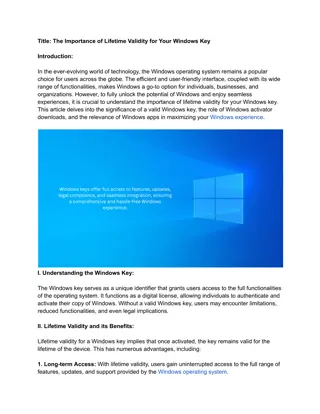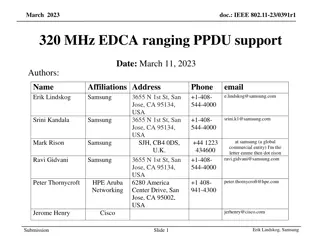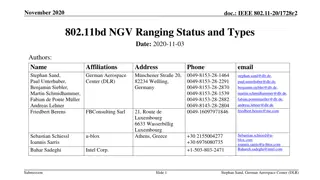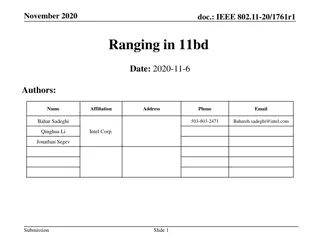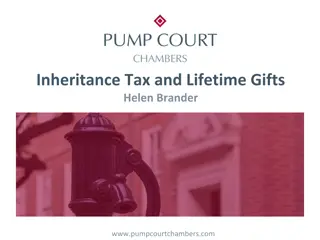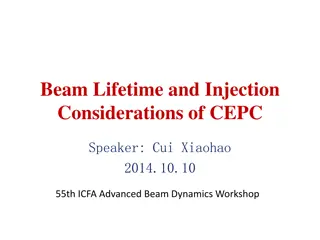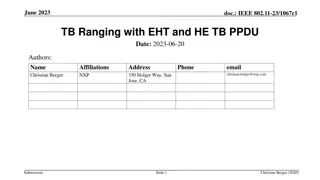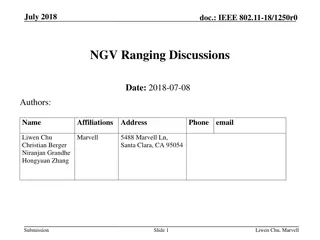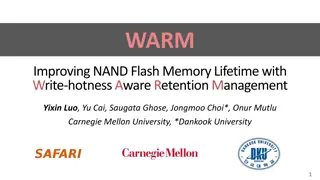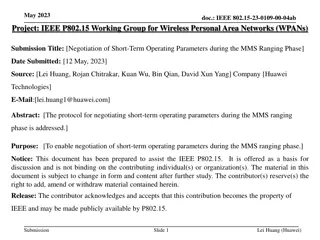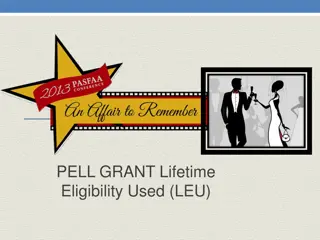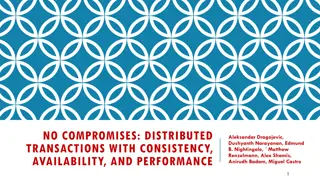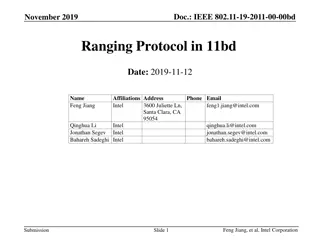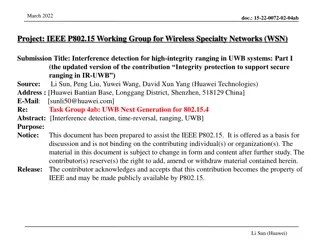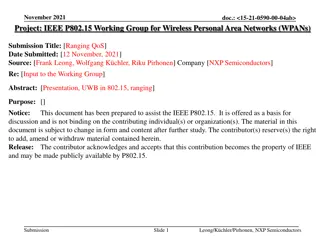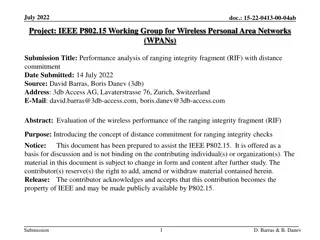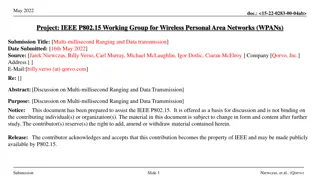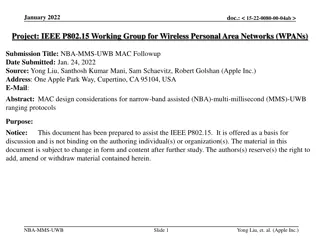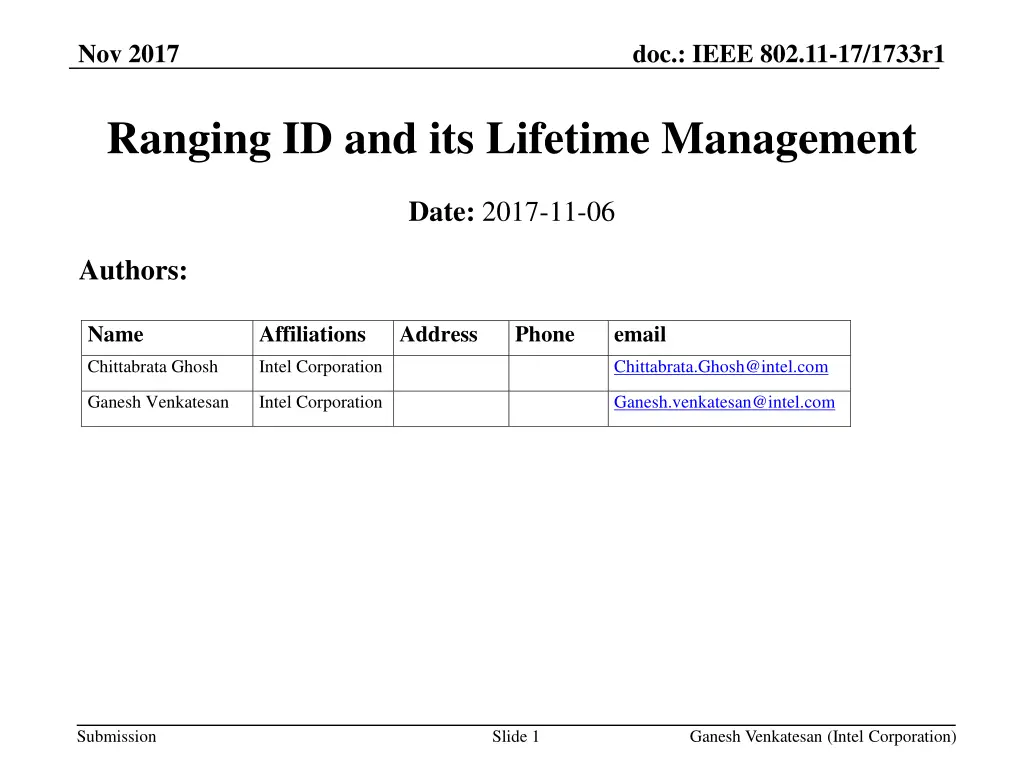
Managing IEEE 802.11 Ranging ID Lifetimes
Explore IEEE 802.11-17/1733r1 on the management of Ranging IDs assigned by APs to unassociated STAs. Learn about releasing resources, lifetime management, and implementation-dependent practices for efficient resource conservation within the network.
Download Presentation

Please find below an Image/Link to download the presentation.
The content on the website is provided AS IS for your information and personal use only. It may not be sold, licensed, or shared on other websites without obtaining consent from the author. If you encounter any issues during the download, it is possible that the publisher has removed the file from their server.
You are allowed to download the files provided on this website for personal or commercial use, subject to the condition that they are used lawfully. All files are the property of their respective owners.
The content on the website is provided AS IS for your information and personal use only. It may not be sold, licensed, or shared on other websites without obtaining consent from the author.
E N D
Presentation Transcript
Nov 2017 doc.: IEEE 802.11-17/1733r1 Ranging ID and its Lifetime Management Date: 2017-11-06 Authors: Name Affiliations Address Phone email Chittabrata Ghosh Intel Corporation Chittabrata.Ghosh@intel.com Ganesh Venkatesan Intel Corporation Ganesh.venkatesan@intel.com Submission Slide 1 Ganesh Venkatesan (Intel Corporation)
Nov 2017 doc.: IEEE 802.11-17/1733r1 Motivation/Background Ranging Id is assigned by an AP to unassociated STAs that initiated a MU iFTMR with the AP The assigned Ranging ID is communicated via the iFTM that the AP sends in response to iFTMR to the STA The assignment and maintenance of the Ranging ID consumes resources in the AP To conserve resources AP s would like to release resources associated with inactive Ranging IDs as soon as possible This submission discusses Ranging ID lifetime and management Submission Slide 2 Ganesh Venkatesan (Intel Corporation)
Nov 2017 doc.: IEEE 802.11-17/1733r1 Ranging ID Lifetime AP has an implementation dependent Ranging ID lifetime Lifetime of all Ranging IDs assigned by the AP If the STA to which a Ranging ID is assigned by the AP does not initiate a Range Measurement Request to the AP within the Ranging ID lifetime, the Ranging ID assignment is retired The STA must obtain a new Ranging ID in order to initiate a Range Measurement with the AP this requires the STA to send an iFTMR and receive an iFTM with the status set to SUCCESS does initiate a Range Measurement within the Ranging ID lifetime(at time = t), the subsequent Range Measurement request from rhe STA to the AP must be received by the AP before time = t + lifetime Slide 3 Ganesh Venkatesan (Intel Corporation) Submission
Nov 2017 doc.: IEEE 802.11-17/1733r1 How does this work (an example)? TR (Range) TR (Range) TR (Range) TR (Poll) TR (Poll) TR (Poll) ` AP STA1 (RID-1) STA2 (RID-2) STA3 (RID-3) STA4 (RID-4) Ranging ID Lifetime STA5 (RID-5) Poll Resp Poll Resp Poll Resp Submission Slide 4 Ganesh Venkatesan (Intel Corporation)
Nov 2017 doc.: IEEE 802.11-17/1733r1 Straw Poll We support: Ranging IDs are of the same size and range as AIDs and following same rules and limitations. Ranging IDs and AIDs are from same space and non-conflicting. the assignment of Ranging IDs by a RSTA to unassociated ISTA resulting in the execution MU HEz Ranging protocol with the RSTA: the assigned Ranging ID is included in the HEz Specific subelement contained in iFTM. the RSTA may advertise a Ranging ID lifetime which defines the duration for which the Ranging ID remains valid the mechanism to advertise Ranging ID lifetime is TBD the best choice for Ranging ID lifetime value is implementation dependent the Ranging ID is retired at both ISTA and RSTA when the corresponding Ranging ID Lifetime expires which also terminates the FTM session. Ranging ID lifetime may be equal to MAX BSS IDLE PERIOD. When an FTM session terminates or aborts the Ranging ID expires. Termination may be explicit (i.e. using FTM or FTM Req) or implicit due to Ranging ID Lifetime expiration. Support of the Ranging ID Lifetime is optional. Submission Slide 5 Ganesh Venkatesan (Intel Corporation)
Nov 2017 doc.: IEEE 802.11-17/1733r1 Motion Move to add the following text to the 802.11az SFD (Cl. 3.2 Protocol Description), granting the SFD Editor editorial license: Ranging IDs are of the same size and range as AIDs and following same rules and limitations. Ranging IDs and AIDs are from same space and non-conflicting. the assignment of Ranging IDs by a RSTA to unassociated ISTA resulting in the execution MU HEz Ranging protocol with the RSTA: the assigned Ranging ID is included in the HEz Specific subelement contained in iFTM. the RSTA may advertise a Ranging ID lifetime which defines the duration for which the Ranging ID remains valid the mechanism to advertise Ranging ID lifetime is TBD the best choice for Ranging ID lifetime value is implementation dependent the Ranging ID is retired at both ISTA and RSTA when the corresponding Ranging ID Lifetime expires which also terminates the FTM session. Ranging ID lifetime may be equal to MAX BSS IDLE PERIOD. When an FTM session terminates or aborts the Ranging ID expires. Termination may be explicit (i.e. using FTM or FTM Req) or implicit due to Ranging ID Lifetime expiration. Support of the Ranging ID Lifetime is optional. Moved: Ganesh Venkatesan; Seconded: Submission Slide 6 Ganesh Venkatesan (Intel Corporation)
Nov 2017 doc.: IEEE 802.11-17/1733r1 Backup Submission Slide 7 Ganesh Venkatesan (Intel Corporation)
Nov 2017 doc.: IEEE 802.11-17/1733r1 How is the Ranging ID Advertised? In iFTM (HEz-specific sub-element) Probably the best way to communicate this value Delivered along with the Ranging ID The lifetime alone does not make sense As a capability Submission Slide 8 Ganesh Venkatesan (Intel Corporation)
Nov 2017 doc.: IEEE 802.11-17/1733r1 What would be the best choice for the value of the Ranging ID Lifetime? Should allow for reuse of Ranging IDs as fast as possible Could be as large as BSS Max Idle Period? Would match associated STA behavior is this needed? Would tie-up Ranging IDs for too long Security implications of having an unused Ranging ID live longer than needed Best to set the Ranging ID Lifetime in such a way that the Ranging ID is retired as soon as one of the following happens: FTM session is torn down explicitly The initiator does not initiate a new Ranging Measurement before the (last LMR delivery + Ranging ID lifetime) Slide 9 Submission Ganesh Venkatesan (Intel Corporation)
Nov 2017 doc.: IEEE 802.11-17/1733r1 Other Issues to consider What happens if the STA with Ranging ID is never Polled? Ranging ID lifetime determination should consider the worst case scenario for a STA to be polled. What happens of the RSTA switches between SU and MU modes of ranging with a STA that is assigned a Ranging ID? Ranging ID lifetime be renewed when a ranging happens (irrespective of the ranging being SU or MU) Submission Slide 10 Ganesh Venkatesan (Intel Corporation)

